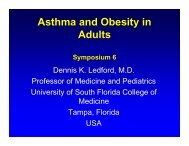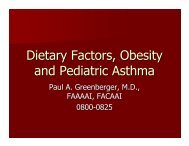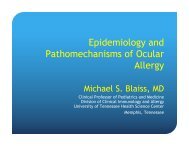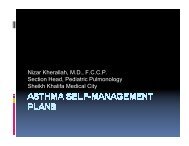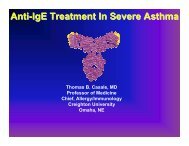scientific program - World Allergy Organization
scientific program - World Allergy Organization
scientific program - World Allergy Organization
Create successful ePaper yourself
Turn your PDF publications into a flip-book with our unique Google optimized e-Paper software.
10<br />
PRECAUTIONS (continued) ADVERSE REACTIONS (continued)<br />
Pediatric Use: The safety of ZYRTEC has been demonstrated in pediatric patients aged 6 months to 11 years. The safety of<br />
ZYRTEC, at daily doses of 5 or 10 mg, has been demonstrated in 376 pediatric patients aged 6 to 11 years in placebo-controlled<br />
trials lasting up to four weeks and in 254 patients in a non-placebo-controlled 12-week trial. The safety of cetirizine has been<br />
demonstrated in 168 patients aged 2 to 5 years in placebo-controlled trials of up to 4 weeks duration. On a mg/kg basis, most of<br />
the 168 patients received between 0.2 and 0.4 mg/kg of cetirizine HCl. The safety of cetirizine in 399 patients aged 12 to 24<br />
months has been demonstrated in a placebo-controlled 18-month trial, in which the average dose was 0.25 mg/kg bid, corresponding<br />
to a range of 4 to 11 mg/day. The safety of ZYRTEC syrup has been demonstrated in 42 patients aged 6 to 11 months in<br />
a placebo-controlled 7-day trial. The prescribed dose was 0.25 mg/kg bid, which corresponded to a mean of 4.5 mg/day, with a<br />
range of 3.4 to 6.2 mg/day.<br />
The effectiveness of ZYRTEC for the treatment of allergic rhinitis and chronic idiopathic urticaria in pediatric patients aged<br />
6 months to 11 years is based on an extrapolation of the demonstrated efficacy of ZYRTEC in adults with these conditions and the<br />
likelihood that the disease course, pathophysiology and the drug’s effect are substantially similar between these two populations.<br />
Efficacy is extrapolated down to 6 months of age for perennial allergic rhinitis and down to 2 years of age for seasonal allergic<br />
rhinitis because these diseases are thought to occur down to these ages in children. The recommended doses for the pediatric<br />
population are based on cross-study comparisons of the pharmacokinetics and pharmacodynamics of cetirizine in adult and<br />
pediatric subjects and on the safety profile of cetirizine in both adult and pediatric patients at doses equal to or higher than the<br />
recommended doses. The cetirizine AUC and Cmax in pediatric subjects aged 6 to 23 months who received a mean of 2.3 mg in a<br />
single dose, and in subjects aged 2 to 5 years who received a single dose of 5 mg of cetirizine syrup and in pediatric subjects<br />
aged 6 to 11 years who received a single dose of 10 mg of cetirizine syrup were estimated to be intermediate between that<br />
observed in adults who received a single dose of 10 mg of cetirizine tablets and those who received a single dose of 20 mg of<br />
cetirizine tablets.<br />
The safety and effectiveness of cetirizine in pediatric patients under the age of 6 months have not been established.<br />
ADVERSE REACTIONS<br />
Controlled and uncontrolled clinical trials conducted in the United States and Canada included more than 6000 patients aged<br />
12 years and older, with more than 3900 receiving ZYRTEC at doses of 5 to 20 mg per day. The duration of treatment ranged from<br />
1 week to 6 months, with a mean exposure of 30 days.<br />
Most adverse reactions reported during therapy with ZYRTEC were mild or moderate. In placebo-controlled trials, the incidence<br />
of discontinuations due to adverse reactions in patients receiving ZYRTEC 5 or 10 mg was not significantly different from<br />
placebo (2.9% vs. 2.4%, respectively).<br />
The most common adverse reaction in patients aged 12 years and older that occurred more frequently on ZYRTEC than<br />
placebo was somnolence. The incidence of somnolence associated with ZYRTEC was dose related, 6% in placebo, 11% at 5 mg<br />
and 14% at 10 mg. Discontinuations due to somnolence for ZYRTEC were uncommon (1.0% on ZYRTEC vs. 0.6% on placebo).<br />
Fatigue and dry mouth also appeared to be treatment-related adverse reactions. There were no differences by age, race, gender<br />
or by body weight with regard to the incidence of adverse reactions.<br />
Table 1 lists adverse experiences in patients aged 12 years and older which were reported for ZYRTEC 5 and 10 mg in controlled<br />
clinical trials in the United States and that were more common with ZYRTEC than placebo.<br />
Table 1.<br />
Adverse Experiences Reported in Patients Aged 12 Years and Older in<br />
Placebo-Controlled United States ZYRTEC Trials (Maximum Dose of 10 mg)<br />
at Rates of 2% or Greater (Percent Incidence)<br />
Adverse ZYRTEC Placebo<br />
Experience (N=2034) (N=1612)<br />
Somnolence 13.7 6.3<br />
Fatigue 15.9 2.6<br />
Dry Mouth 15.0 2.3<br />
Pharyngitis 12.0 1.9<br />
Dizziness 12.0 1.2<br />
In addition, headache and nausea occurred in more than 2% of the patients, but were more common in placebo patients.<br />
Pediatric studies were also conducted with ZYRTEC. More than 1300 pediatric patients aged 6 to 11 years with more than 900<br />
treated with ZYRTEC at doses of 1.25 to 10 mg per day were included in controlled and uncontrolled clinical trials conducted in<br />
the United States. The duration of treatment ranged from 2 to 12 weeks. Placebo-controlled trials up to<br />
4 weeks duration included 168 pediatric patients aged 2 to 5 years who received cetirizine, the majority of whom received single<br />
daily doses of 5 mg. A placebo-controlled trial 18 months in duration included 399 patients aged 12 to 24 months treated with<br />
cetirizine (0.25 mg/kg bid), and another placebo-controlled trial of 7 days duration included 42 patients aged 6 to 11 months who<br />
were treated with cetirizine (0.25 mg/kg bid).<br />
The majority of adverse reactions reported in pediatric patients aged 2 to 11 years with ZYRTEC were mild or moderate. In<br />
placebo-controlled trials, the incidence of discontinuations due to adverse reactions in pediatric patients receiving up to 10 mg of<br />
ZYRTEC was uncommon (0.4% on ZYRTEC vs. 1.0% on placebo).<br />
Table 2 lists adverse experiences which were reported for ZYRTEC 5 and 10 mg in pediatric patients aged 6 to 11 years in<br />
placebo-controlled clinical trials in the United States and were more common with ZYRTEC than placebo. Of these, abdominal<br />
pain was considered treatment-related and somnolence appeared to be dose-related, 1.3% in placebo, 1.9% at 5 mg and 4.2% at<br />
10 mg. The adverse experiences reported in pediatric patients aged 2 to 5 years in placebo-controlled trials were qualitatively<br />
similar in nature and generally similar in frequency to those reported in trials with children aged 6 to 11 years.<br />
In the placebo-controlled trials of pediatric patients 6 to 24 months of age, the incidences of adverse experiences, were similar<br />
in the cetirizine and placebo treatment groups in each study. Somnolence occurred with essentially the same frequency in<br />
patients who received cetirizine and patients who received placebo. In a study of 1 week duration in children 6-11 months of age,<br />
patients who received cetirizine exhibited greater irritability/fussiness than patients on placebo. In a study of 18 months duration<br />
in patients 12 months and older, insomnia occurred more frequently in patients who received cetirizine compared to patients who<br />
received placebo (9.0% v. 5.3%). In those patients who received 5 mg or more per day of cetirizine as compared to patients who<br />
received placebo, fatigue (3.6% v. 1.3%) and malaise (3.6% v. 1.8%) occurred more frequently.<br />
Table 2.<br />
Adverse Experiences Reported in Pediatric Patients Aged 6 to 11 Years in<br />
Placebo-Controlled United States ZYRTEC Trials (5 or 10 mg Dose) Which Occurred<br />
at a Frequency of �2% in Either the 5-mg or the 10-mg ZYRTEC Group, and More<br />
Frequently Than in the Placebo Group<br />
ZYRTEC<br />
Adverse Placebo 5 mg 10 mg<br />
Experiences (N=309) (N=161) (N=215)<br />
Headache 12.3% 11.0% 14.0%<br />
Pharyngitis 2.9% 6.2% 2.8%<br />
Abdominal pain 1.9% 4.4% 5.6%<br />
Coughing 3.9% 4.4% 2.8%<br />
Somnolence 1.3% 1.9% 4.2%<br />
Diarrhea 1.3% 3.1% 1.9%<br />
Epistaxis 2.9% 3.7% 1.9%<br />
Bronchospasm 1.9% 3.1% 1.9%<br />
Nausea 1.9% 1.9% 2.8%<br />
Vomiting 1.0% 2.5% 2.3%<br />
The following events were observed infrequently (less than 2%), in either 3982 adults and children 12 years and older or in 659<br />
pediatric patients aged 6 to 11 years who received ZYRTEC in U.S. trials, including an open adult study of six months duration.<br />
A causal relationship of these infrequent events with ZYRTEC administration has not been established.<br />
Autonomic Nervous System: anorexia, flushing, increased salivation, urinary retention.<br />
Cardiovascular: cardiac failure, hypertension, palpitation, tachycardia.<br />
Central and Peripheral Nervous Systems: abnormal coordination, ataxia, confusion, dysphonia, hyperesthesia, hyperkinesia,<br />
hypertonia, hypoesthesia, leg cramps, migraine, myelitis, paralysis, paresthesia, ptosis, syncope, tremor, twitching, vertigo,<br />
visual field defect.<br />
Gastrointestinal: abnormal hepatic function, aggravated tooth caries, constipation, dyspepsia, eructation, flatulence, gastritis,<br />
hemorrhoids, increased appetite, melena, rectal hemorrhage, stomatitis including ulcerative stomatitis, tongue discoloration,<br />
tongue edema.<br />
Genitourinary: cystitis, dysuria, hematuria, micturition frequency, polyuria, urinary incontinence, urinary tract infection.<br />
Hearing and Vestibular: deafness, earache, ototoxicity, tinnitus.<br />
Metabolic/Nutritional: dehydration, diabetes mellitus, thirst.<br />
Musculoskeletal: arthralgia, arthritis, arthrosis, muscle weakness, myalgia.<br />
Psychiatric: abnormal thinking, agitation, amnesia, anxiety, decreased libido, depersonalization, depression, emotional lability,<br />
euphoria, impaired concentration, insomnia, nervousness, paroniria, sleep disorder.<br />
Respiratory System: bronchitis, dyspnea, hyperventilation, increased sputum, pneumonia, respiratory disorder, rhinitis, sinusitis,<br />
upper respiratory tract infection.<br />
Reproductive: dysmenorrhea, female breast pain, intermenstrual bleeding, leukorrhea, menorrhagia, vaginitis.<br />
Reticuloendothelial: lymphadenopathy.<br />
Skin: acne, alopecia, angioedema, bullous eruption, dermatitis, dry skin, eczema, erythematous rash, furunculosis, hyperkeratosis,<br />
hypertrichosis, increased sweating, maculopapular rash, photosensitivity reaction, photosensitivity toxic reaction, pruritus,<br />
purpura, rash, seborrhea, skin disorder, skin nodule, urticaria.<br />
Special Senses: parosmia, taste loss, taste perversion.<br />
Vision: blindness, conjunctivitis, eye pain, glaucoma, loss of accommodation, ocular hemorrhage, xerophthalmia.<br />
Body as a Whole: accidental injury, asthenia, back pain, chest pain, enlarged abdomen, face edema, fever, generalized edema,<br />
hot flashes, increased weight, leg edema, malaise, nasal polyp, pain, pallor, periorbital edema, peripheral edema, rigors.<br />
Occasional instances of transient, reversible hepatic transaminase elevations have occurred during cetirizine therapy. Hepatitis<br />
with significant transaminase elevation and elevated bilirubin in association with the use of ZYRTEC has been reported.<br />
In foreign marketing experience the following additional rare, but potentially severe adverse events have been reported: anaphylaxis,<br />
cholestasis, glomerulonephritis, hemolytic anemia, hepatitis, orofacial dyskinesia, severe hypotension, stillbirth, and<br />
thrombocytopenia.<br />
DRUG ABUSE AND DEPENDENCE<br />
There is no information to indicate that abuse or dependency occurs with ZYRTEC.<br />
OVERDOSAGE<br />
Overdosage has been reported with ZYRTEC. In one adult patient who took 150 mg of ZYRTEC, the patient was somnolent but did<br />
not display any other clinical signs or abnormal blood chemistry or hematology results. In an 18 month old pediatric patient who<br />
took an overdose of ZYRTEC (approximately 180 mg), restlessness and irritability were observed initially; this was followed by<br />
drowsiness. Should overdose occur, treatment should be symptomatic or supportive, taking into account any concomitantly<br />
ingested medications. There is no known specific antidote to ZYRTEC. ZYRTEC is not effectively removed by dialysis, and dialysis<br />
will be ineffective unless a dialyzable agent has been concomitantly ingested. The acute minimal lethal oral doses were 237 mg/kg<br />
in mice (approximately 95 times the maximum recommended daily oral dose in adults on a mg/m2 basis, or approximately 40<br />
times the maximum recommended daily oral dose in infants on a mg/m2 basis) and 562 mg/kg in rats (approximately 460 times<br />
the maximum recommended daily oral dose in adults on a mg/m2 basis, or approximately 190 times the maximum recommended<br />
daily oral dose in infants on a mg/m2 basis). In rodents, the target of acute toxicity was the central nervous system, and the target<br />
of multiple-dose toxicity was the liver.<br />
DOSAGE AND ADMINISTRATION<br />
Adults and Children 12 Years and Older: The recommended initial dose of ZYRTEC is 5 or 10 mg per day in adults and children<br />
12 years and older, depending on symptom severity. Most patients in clinical trials started at 10 mg. ZYRTEC is given as a single<br />
daily dose, with or without food. The time of administration may be varied to suit individual patient needs.<br />
Children 6 to 11 Years: The recommended initial dose of ZYRTEC in children aged 6 to 11 years is 5 or 10 mg (1 or 2 teaspoons)<br />
once daily depending on symptom severity. The time of administration may be varied to suit individual patient needs.<br />
Children 2 to 5 Years: The recommended initial dose of ZYRTEC syrup in children aged 2 to 5 years is 2.5 mg (1/2 teaspoon) once<br />
daily. The dosage in this age group can be increased to a maximum dose of 5 mg per day given as 1 teaspoon (5 mg) once daily, or<br />
as 1/2 teaspoon (2.5 mg) given every 12 hours.<br />
Children 6 months to





